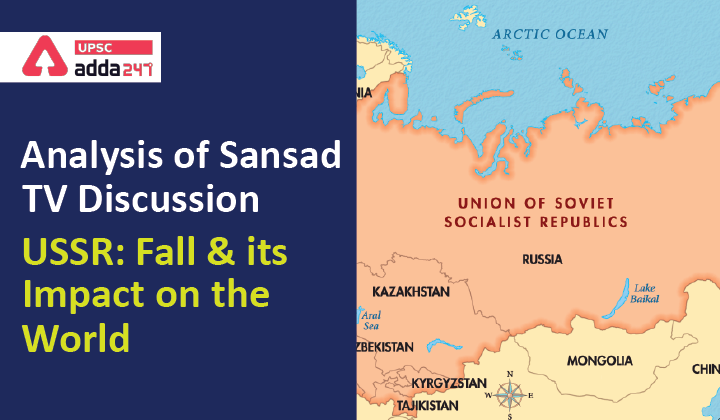Table of Contents
Introduction
- Thirty years ago, a defining event of the 20th century took place, the Union of Soviet Socialist Republics dissolved, marking the end of the once-mighty communist empire, which spanned Eastern, Southern and Northern Europe and Central and Northern Asia for seventy years.
- Thirty years ago, the Soviet Union dissolved as the result of internal political, economic, and ethnic disintegration within the USSR following General Secretary Mikhail Gorbachev’s effort to reform the Soviet political and economic system.
- In an attempt to end the ‘Era of Stagnation’, Gorbachev launched ‘perestroika’, a political movement for reformation within the Communist Party of the Soviet Union designed to boost the economy.
About USSR
- The Union of Soviet Socialist Republics (USSR) was created after the socialist revolution in Russia in 1917, which ended the Russian empire.
- The USSR was a loose confederation of 15 republics and Russia was the leader. It was a strong segment with great control over the politics of the entire world from 1922 to 1991 when it was disintegrated into smaller units, mainly due to Mikhael Gorbachev’s economic and political reforms- Perestroika and Glasnost respectively.
- This led to the end of the cold war between the two superpowers USA and the USSR. It was marked by events like the fall of the Berlin Wall and the power shift from the Soviet centre to the republics. The breakdown of the USSR made the USA the sole global power, ending the bipolarity in the world order.
Major Events that led to the disintegration of the USSR
The following were the main reasons for the disintegration of the USSR:
- Socialist bloc crisis: The people from many east European countries started protesting against their own governments and USSR without the right intervention from USSR at the right time. Communist governments in the Second World War collapsed one after the other without the right intervention from USSR at the right time.
- Fall of Berlin Wall: After the Second World War Germany was divided among the socialist USSR and the capitalist western regimes. The fall of Berlin led to a series of events including the disintegration of the USSR. Political and Economic reforms in USSR: Gorbachev realized the economic and political problems of the USSR, and started a series of reforms, with the intention to revive the economy and settle economic problems. This was more closely associated with the market economy and was a deviation from the communist policies. Many communist leaders in USSR opposed to reforms initiated by Gorbachev. They encouraged a coup in the year 1991.
- Opposition against the coup: Boris Yeltsin, who won the popular election in the Russian Republic, also protested against the coup and central control of the USSR. The freedom for republics became the slogan. Boris Yeltsin and the pluralist movement advocated democratization and rapid economic reforms. The hard-line Communist elite wanted to thwart Gorbachev’s reform agenda. The power shift from the Soviet centre to republics: Republics like Russia, Ukraine, and Belarus emerged as powerful countries. They declared that the Soviet Union as being disbanded.
Factors that led to the disintegration of the USSR
The factors that led to the disintegration of the USSR are as follows:
- Economic Weakness: The weakness in the economy at that time was the major cause of dissatisfaction among the people in the USSR. There was a huge shortage of consumer items. The reasons for economic weakness were as follows: A Huge amount was spent on the military. In Eastern Europe, there was large maintenance of satellite states Maintenance of the Central Asian Republics within the USSR states.
- Political Un-accountability: There was a single-party rule for around 70 years that turned authoritarian. There were widespread corruption and a lack of transparency in the system. Gorbachev made a decision to allow elections with a multi-party system and create a presidency for the Soviet Union. This began a slow process of democratization that eventually destabilized Communist control and contributed to the collapse of the Soviet Union.
- Gorbachev’s reforms: Once freedom was achieved under Michael Gorbachev’s reforms, they demanded more for it. The demand grew into a big force which turned very difficult to control. The people wanted to catch up on the western side very quickly.
- Rise of nationalism: There was a rise of nationalism among countries like Russia, Baltic republics, Ukraine, Georgia etc. This is the most important and immediate cause of the disintegration of the USSR. The national feeling was strong among the most prosperous areas in USSR and not in Central Asian republics. Ordinary people among prosperous republics never liked to pay the big price to uplift the backward Central Asian republics.
Importance of Ukraine in the former USSR?
- Ukraine, as the most populous republic after the Russian Federation, played a key role not only in the creation of the USSR but also in its dissolution. It was the Ukrainian referendum of December 1 1991, in which over 90 per cent of participants voted to leave the USSR, that spelt the end of the cold war superpower.
What is the current Ukraine Crisis?
- The current situation comes after eight years of war in Ukraine, and with, apart from Vladimir Putin, a new set of leaders on all sides.
- The crisis erupted on December 17 when Russia presented the west with an unexpected ultimatum. Its list of demands included a commitment in writing to halt any further eastward expansion of Nato, the removal of multinational Nato troops from Poland and the Baltic states, and the possible withdrawal of US nuclear weapons from Europe. Most crucial was that Ukraine never be allowed to join the alliance.
- Russia now gives the impression of moving faster than ever before to re-establish its control over the post-Soviet space.
- The Kremlin’s support for Alexander Lukashenko of Belarus has helped him to quash peaceful protests against his corrupt rule. Russian military intervention in Kazakhstan helped President Kassym-Jomart Tokayev put an end to the violent protests in that country.
Consequences of the disintegration of the USSR
The major consequences of the disintegration of the USSR upon countries like India were:
- End of ideological battle: The disintegration of the USSR showed the lacunae of the socialistic model of economic governance to the developing world. It was seen as a victory of capitalism over socialism, often termed as the ‘end of ideology’ thesis.
- Rise of free-market economic model: Dominance of western institutions like IMF and World Bank in the global economic governance pushed developing countries to adopt neo-liberal economic policies. India adopted a free-market economic model in the form of LPG reforms post-1991.
- The decline in financial aid to other countries: Though a member of NAM, India had mutual strategic cooperation with the USSR as per its 1971 Indo–Soviet Treaty of Peace, Friendship and Cooperation. The financial aid from the Soviet Union to India was significantly reduced due to the disintegration of the USSR. This was also one of the reasons for the balance of payments crisis of India in 1991.
- Reorganization of Eastern Europe: Changes in the politics of Europe led to the dilution of division between Western and Eastern Europe. Demolition of the Berlin Wall, the unification of Germany, the end of the Warsaw Pact and the rise of democratic regimes changed the politics of Europe. The membership of the European Union enlarged, leading to the emergence of a new economic bloc -the EU.
- Rise of Central Asia: Central Asia became a new centre of global interest particularly from Chinese expansionist ambitions in the region.
Conclusion
The disintegration of the USSR resulted in a phase of the USA’s dominance in world politics. Countries like India maintained good relations with Russia post-disintegration and shared the idea of having a multipolar world order.



 TSPSC Group 1 Question Paper 2024, Downl...
TSPSC Group 1 Question Paper 2024, Downl...
 TSPSC Group 1 Answer key 2024 Out, Downl...
TSPSC Group 1 Answer key 2024 Out, Downl...
 UPSC Prelims 2024 Question Paper, Downlo...
UPSC Prelims 2024 Question Paper, Downlo...





